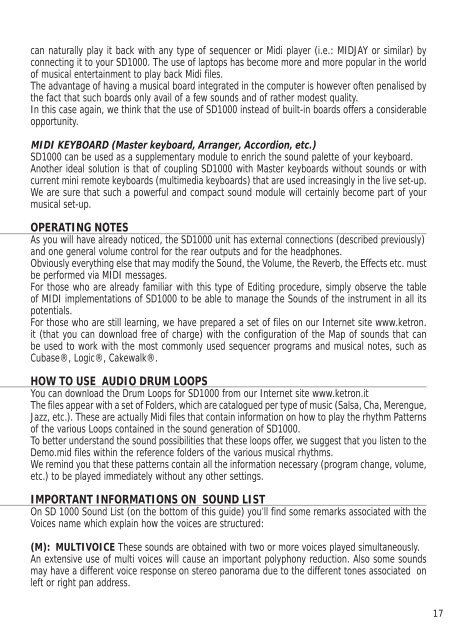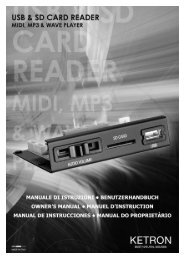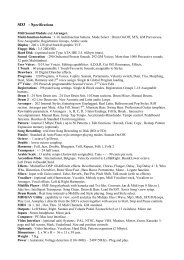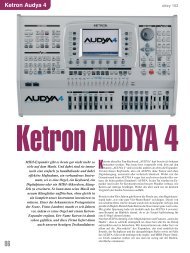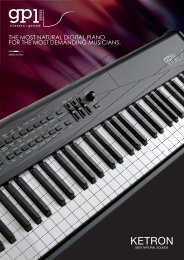manuale di istruzioni • benutzerhandbuch owner's manual ... - Ketron
manuale di istruzioni • benutzerhandbuch owner's manual ... - Ketron
manuale di istruzioni • benutzerhandbuch owner's manual ... - Ketron
- No tags were found...
Create successful ePaper yourself
Turn your PDF publications into a flip-book with our unique Google optimized e-Paper software.
can naturally play it back with any type of sequencer or Mi<strong>di</strong> player (i.e.: MIDJAY or similar) byconnecting it to your SD1000. The use of laptops has become more and more popular in the worldof musical entertainment to play back Mi<strong>di</strong> files.The advantage of having a musical board integrated in the computer is however often penalised bythe fact that such boards only avail of a few sounds and of rather modest quality.In this case again, we think that the use of SD1000 instead of built-in boards offers a considerableopportunity.MIDI KEYBOARD (Master keyboard, Arranger, Accor<strong>di</strong>on, etc.)SD1000 can be used as a supplementary module to enrich the sound palette of your keyboard.Another ideal solution is that of coupling SD1000 with Master keyboards without sounds or withcurrent mini remote keyboards (multime<strong>di</strong>a keyboards) that are used increasingly in the live set-up.We are sure that such a powerful and compact sound module will certainly become part of yourmusical set-up.OPERATING NOTESAs you will have already noticed, the SD1000 unit has external connections (described previously)and one general volume control for the rear outputs and for the headphones.Obviously everything else that may mo<strong>di</strong>fy the Sound, the Volume, the Reverb, the Effects etc. mustbe performed via MIDI messages.For those who are already familiar with this type of E<strong>di</strong>ting procedure, simply observe the tableof MIDI implementations of SD1000 to be able to manage the Sounds of the instrument in all itspotentials.For those who are still learning, we have prepared a set of files on our Internet site www.ketron.it (that you can download free of charge) with the configuration of the Map of sounds that canbe used to work with the most commonly used sequencer programs and musical notes, such asCubase®, Logic®, Cakewalk®.HOW TO USE AUDIO DRUM LOOPSYou can download the Drum Loops for SD1000 from our Internet site www.ketron.itThe files appear with a set of Folders, which are catalogued per type of music (Salsa, Cha, Merengue,Jazz, etc.). These are actually Mi<strong>di</strong> files that contain information on how to play the rhythm Patternsof the various Loops contained in the sound generation of SD1000.To better understand the sound possibilities that these loops offer, we suggest that you listen to theDemo.mid files within the reference folders of the various musical rhythms.We remind you that these patterns contain all the information necessary (program change, volume,etc.) to be played imme<strong>di</strong>ately without any other settings.IMPORTANT INFORMATIONS ON SOUND LISTOn SD 1000 Sound List (on the bottom of this guide) you’ll find some remarks associated with theVoices name which explain how the voices are structured:(M): MULTIVOICE These sounds are obtained with two or more voices played simultaneously.An extensive use of multi voices will cause an important polyphony reduction. Also some soundsmay have a <strong>di</strong>fferent voice response on stereo panorama due to the <strong>di</strong>fferent tones associated onleft or right pan address.17


